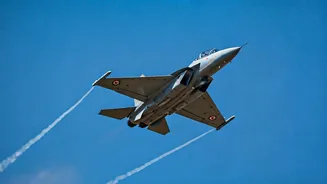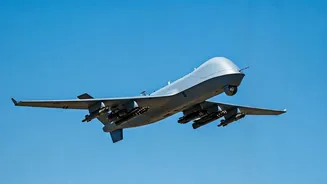A Historic Milestone
The Indian skies recently witnessed an event of immense significance: the inaugural flight of an indigenous fighter trainer. This achievement represents
a pivotal moment in India's ongoing efforts towards self-reliance in defense technology. This flight is a testament to the capabilities of Indian engineers and the country's dedication to developing advanced military technologies domestically. The success of this initiative is expected to bolster India's defense preparedness, enabling it to better protect its borders and maintain its sovereignty. This initiative marks a crucial step in the country's journey towards becoming a self-sufficient nation in the defense sector. The successful test flight is evidence of the nation's focus on technological advancements in the field of aviation and defense.
Boosting Indigenous Capabilities
This achievement is not simply a triumph in aviation technology; it is also a powerful symbol of India's developing capacity in the defense arena. The success in developing and flying this indigenous warplane indicates a notable decrease in reliance on foreign imports and a boost to local manufacturing capabilities. Such initiatives stimulate the domestic economy and generate employment opportunities in the engineering and aerospace sectors, while also decreasing the costs related to the procurement of defense equipment. This focus on indigenous development reinforces national pride and strengthens India's strategic autonomy. This step not only advances the nation's defense capabilities but also advances the vision of Atmanirbhar Bharat (Self-Reliant India). This initiative has demonstrated India's dedication to improving its defense industry.
Strategic Implications Explored
The successful flight of the indigenous fighter trainer has notable implications for India's defense strategy. The introduction of this warplane will improve pilot training and enhance the operational capabilities of the Air Force. This new technology ensures that India maintains its competitive edge in the regional aviation landscape. Furthermore, the capacity to create these fighter trainers domestically allows for customization to fulfill the unique requirements of the Indian Air Force. This strategic flexibility is critical in responding to developing security challenges and guaranteeing the country's security interests. This milestone in aviation technology has the potential to enhance India's international standing and help it become a significant force in the global defense market. This achievement emphasizes India's dedication to strengthening its defense capabilities.
Future Prospects Assessed
Looking ahead, the success of the indigenous fighter trainer opens up exciting prospects for India's aviation industry. The expertise acquired in designing, developing, and manufacturing this warplane will pave the way for more sophisticated defense projects in the future. The government's continued support for research and development, together with investments in infrastructure and human capital, is crucial for fostering innovation and encouraging the growth of the defense sector. Moreover, the success of this project could spur international collaboration and technology transfers, fostering knowledge sharing and cooperation with other countries. This initiative signifies India's commitment to technological excellence and its objective of establishing a robust and self-sufficient defense ecosystem. The future of Indian aviation looks bright with an increasing focus on indigenous capabilities and technological innovation.

















